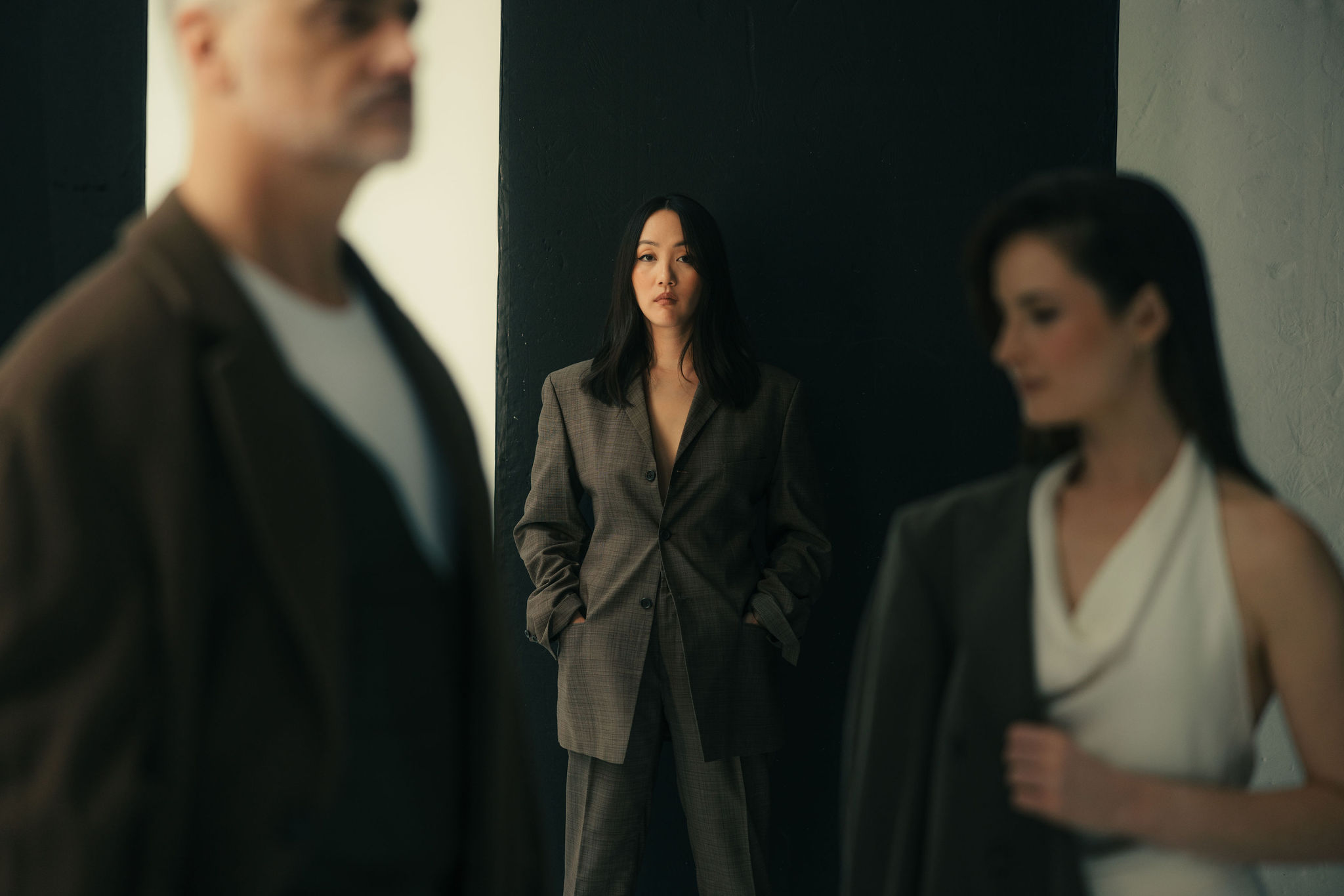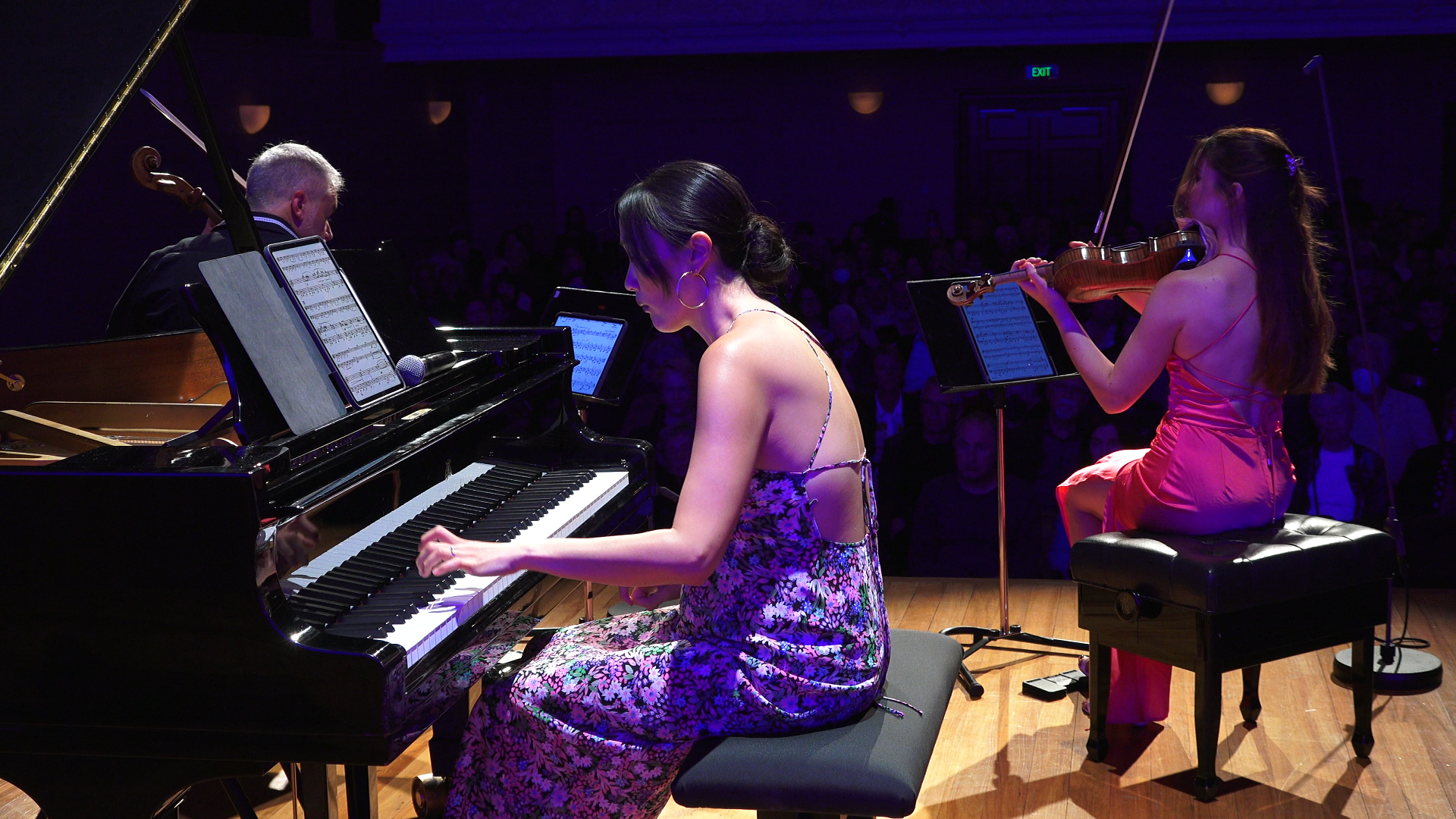Sayonara(h)
Event Details
Join NZTrio at the TSB Wallace Art Centre, Pah Homestead on June 5th, 7pm for their final performance with Sarah as pianist. Yuri Cho is guest violinist, and drinks, nibbles,
Event Details
Join NZTrio at the TSB Wallace Art Centre, Pah Homestead on June 5th, 7pm for their final performance with Sarah as pianist. Yuri Cho is guest violinist, and drinks, nibbles, and toasts will follow.
Programme:
Approx. 75 mins no interval
Brahms: Piano Trio no. 2 in C major op. 87 (I: Allegro)
Jack Body: Fire in the Belly
Ravel: Piano Trio (I: Modéré)
Chen Yi: Tibetan Tunes (II: Dui Xie)
Beethoven: Trio in E flat major op. 1 no. 1 (IV: Finale – Presto)
Claire Cowan: Subtle Dances
Saint-Saëns: Piano Trio no. 2 in e minor op. 82 (V: Allegro)
Tickets $40 Adults / $20 Students
General Admission
BOOK NOW VIA EVENTFINDA

Time
June 5, 2018 7:00 pm UTC+12:00(GMT+00:00)
Location
TSB Wallace Art Centre, The Pah Homestead
Programme Notes
Johannes BRAHMS (GER; 1833 – 1897): Trio in C major, Op. 87
I. Allegro moderato
You know what I think of Brahms: after Bach and Beethoven the greatest, the most sublime of all composers. –von Bülow. This was 1882, the year that Hans von Bülow made that famous pronouncement, in a letter to his wife. Brahms had become the third of the three B’s.During this time, Brahms was at the height of his powers. He had two hugely successful symphonies under his belt, as well as the German Requiem and the violin concerto, all of which were making him famous across Europe.
It was also the year that, after all these orchestral successes, he chose to go back to chamber music and song. It was almost 30 years since he’d written a piano trio: and he’d actually begun this two years earlier in Vienna as one of a pair – the other he destroyed! – but this one he deemed worthy of survival and took it with him (along with the string quintet Op 88) to work on over the summer at his favourite spa resort, Bad Ischl outside Salzburg, the scene of so many Brahms masterpieces. And this is one. It’s the most powerful of the trios, the most sophisticated in terms of texture and form, and also the most harmonically daring – listen out for a key change of just a semitone (!) in the first movement. It will grab you right from the unison string opening – that first theme, and the even more beautiful second, underpin the entire trio.
Programme note by Charlotte Wilson
Jack BODY (NZ; 1944 – 2015): Fire in the Belly (NZTrio commission 2006)
Fire in the belly is that energy that impels us to do things, make things, and to act with urgency and a sense of necessity. It is one important source of creative energy, and without it art can be flaccid and dull. It is what teenagers tend to have a lot of, and what aged folk like me need to try to recapture from time to time! The work was commissioned by NZTrio with funding from Creative New Zealand, and I was delighted to receive this invitation from an ensemble which has such a fantastic commitment to NZ music. –Jack Body
Jack Body’s music covers most genres, including solo and chamber music, orchestral music, music theatre, music for dance and film as well as electroacoustic music. He was a specialist in cross-cultural composition both in his own music, and in his teaching at Victoria University of Wellingtonwhere he established a residency for traditional musicians to work collaboratively with composition staff and students. Jack was a prolific world-class composer and ethnomusicologist with global reach. The impact of his artistic life on New Zealand audiences, composers, musicians and students is profound. He received the Arts Foundation Laureate and Icon Award in 2015.
Maurice RAVEL (FRA; 1875 – 1937): Piano Trio in A minor
I. Modéré
This mysterious, elusive, passionate, trio is the work that Ravel was writing when Europe found itself plunged into war. August 1914: he had been working on it for some time – six years, in fact, with his usual fastidiousness – and in earnest since March, taking it with him to St Jean de Luz in Basque country and telling his teacher, Gédalge, “I’ve written my trio. Now all I need are the themes.” What happened instead was the German invasion of France, which gave him all the impetus he needed. He rushed to finish it, “working on the Trio with the sureness and lucidity of a madman”,and immediately tried to enlist as a bomber in the French Air Force. He was rejected: his age (39), and something minor to do with his heart. But he continued applying until finally he was accepted as a truck driver into the 13th Artillery Regiment, driving munitions at night right on the front, under constant German bombardment, until the end of the war. Corresponding with Vaughan Williams throughout this period, he writes inJune 1915:
It seems years since I left Paris: I have had moving, painful, and dangerous enough times to find it astonishing to come out of here still alive. –Ravel
One fancies that you hear some of the threat facing Europe – and Ravel personally – in the largely dark, elusive colours of this trio. But for him it was also a celebration of life, a tribute to his Basque heritage of which he was tremendously proud: his mother was Basque, and her own great love of the Basque language and folk songs had a tremendous influence on his life and music. You can hear the rhythm of the zortziko, a very distinctive Basque folk dance, in the first movement Modéré. Rhythm is key to this whole work, the inexorable weaving together of melodies and harmony: the shimmering atmosphere; the classically perfect form.
Programme note by Charlotte Wilson
Chen YI (China; b. 1953): Tibetan Tunes (2007)
Dui Xie
Trained as a violinist in the European classical tradition, Chen Yi initially came into contact with Chinese folk music in a forced relocation to the countryside during the Cultural Revolution. Already widely celebrated in China as a major new composer during the increasingly open cultural climate of the 1980s, Chen Yi came to the United States in 1986 to continue her musical studies. She writes both intimate and large scale works for European and Chinese instruments, and fuses Western orchestral and choral idioms with traditional Eastern pentatonic tonalities. Her music has since been performed worldwide by orchestras such as the New York Philharmonic and Los Angeles Philharmonic, and by musicians such as Yehudi Menuhin and Yo-Yo Ma. She has held residences in both New York and Missouri and teaches at the University of Missouri–Kansas City Conservatory of Music and Dance.
Commissioned by the Barlow Endowment for Music Composition at Brigham Young University, the two-movement Tibetan Tuneswas written for the New Pacific Trio and was premiered at the Conservatory of Music at University of the Pacific in January 2007 in Stockton, California. The second movement Dui Xie being performed this eveningis a kind of Tibetan folk ensemble music typically played with the plucked instrument Zhamunie, the bamboo flute, and the fiddle Erhu. Chen explains: The music presents the rich gestures of Du Mu (a name of a god in Tibetan Buddhism) in a serene mood.
Ludwig van BEETHOVEN (GER; 1770 – 1827): Piano Trio in E flat Major, Op. 1, No. 1
IV. Finale – Presto
Ludwig van Beethoven was born in Bonn, on the Rhine, shortly before Christmas in 1770. His musical ability showed early and by the time he was 11 years, he was working as an assistant organist at the Electoral chapel and was actively involved in music-making in the houses of the local aristocrats. As a young man, Beethoven became aware of major political and social changes sweeping across Europe. In music, the traditional compositional techniques of the late 18thcentury continued for a time but new ideas were already pushing against the established boundaries. This suited Beethoven and his more emotional and expressive compositions, sometimes embellished with touches of youthful humour. He was eager to take his musical gifts to the much larger city of Vienna, seven days away by stagecoach.
For a composer, their Op. 1 marks the transition from talented student to serious composer. Beethoven had already completed about 20 chamber works when he assigned the three piano trios to his Op.1. Most of the music was composed while he was still living in Bonn – Grove suggests that the first Trio was written before 1794 – and it is possible Beethoven performed movements from them at private concerts before leaving for Vienna in 1792.
The three trios of Op. 1 were formally premiered in 1793 at the Viennese house of Prince Carl Lichnowsky to whom they are dedicated. Most of musical Vienna attended, including Haydn, who was particularly impressed with the first two trios of the set. They were published in 1795.
The E flat Trio is in four movements. In the opening Allegrothe piano leads with upward broken chords – Mannheim Rockets, a popular 18th-century gesture to add virtuosic brilliance. The mood is sparkling and is contrasted by a gentler second subject mainly on the strings. This happily explores scale passages, and references the first subject as the piano gently commences the recapitulation.
In the Adagio cantabile, the piano sings the lyrical theme A-flat theme and is joined by the strings in turn, and then jollied along with some rhythmic and harmonic surprises.
The Scherzois a spirited romp, dramatically contrasted by the long lines of the strings in the trio as the piano takes off with some little Rockets of its own. The Prestofinale opens with a piano leap and plenty of will-of-the-wisp humour. There’s another flash of the Rocket theme and a dazzling finish.
Joy Aberdein © 2012
Claire COWAN (NZ; b. 1983): Subtle Dances (co-commissioned in 2013 by NZTrio and Chamber Music NZ)
Claire is a composer and performer based in Auckland. She studied composition at Auckland University and since graduating with Honours in 2006, has pursued a career in music for concert, film, theatre and TV. Claire is an experienced orchestrator and symphonic writer, having worked with many of New Zealand’s leading orchestras.
Subtle Dances is a set of three short moods for piano trio. In writing, the composer has tried to approach the works as intuitively as possible. For her this creates the greatest connection between composer, performers, and the audience listening. Each work features one instrument more prominently – firstly cello, then piano, then violin. The music explores Cowan’s continued fascination with the space created within the music, in which a listener can engage. Both hypnotic and meditative, the pieces present themselves as a contrasting set of interior landscapes. They are: passing thoughts, memories, unsolvable problems, and explorations of headspace: Firstly – it begins with a dance; a rhythmical and passionate interlocking of playful lines, but not without an element of danger or risk.Secondly – an elegy, the body in its slowest state. Thirdly – a struggle, an unanswered question, a cycle – and ultimately, a transition; a bursting through, into a new light.
Camille SAINT-SAËNS (1835 – 1921): Piano Trio No. 2 in E minor, Opus 92 (1892)
V. Allegro
I am working quietly away at a trio which I hope will drive to despair all those unlucky enough to hear it. I shall need the whole summer to perpetrate this atrocity; one must have a little fun somehow. –Saint-Saëns
Saint-Saëns was 56 and at the height of his career when he wrote this, the second of his three piano trios. Another prodigy pianist, like Chopin: he had begun playing at the age of 2½, and by the time he was 10 he was giving public concerts of the complete Beethoven sonatas – from memory! He started at the Paris conservatoire when he was 13 and has one of the longest careers in the music business, with a chamber music output that spans 70 years, right up until the year of his death. It was a difficult life – an only child, he was brought up by his mother and grandmother after his father died. His own two infant sons died tragically within weeks of each other, his marriage broke up, and after his mother died he spent much of the rest of his life travelling, accompanied only by his dog.
He began this trio in the spring of 1892 at his favourite holiday spot, Pointe Pescade in Algeria, where he ended up settling in his old age. It had been almost 30 years since he had written his first trio and he poured himself into it, writing to a friend: “I will bring back a ‘Trio’ with piano, which has been lying around in my head for who knows how long and of which I need to rid myself. And this is no small affair! I don’t claim that it will please these gentlemen, but it must please me, and I have my requirements which are not slight.” The result was a five-movement masterpiece, of which we will hear the fifth Allegrothis evening, and it certainly did please the gentlemen critics – it’s been called the greatest French piano trio of the 19th century.
Programme notes by Charlotte Wilson.


